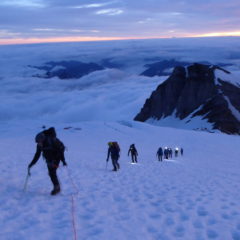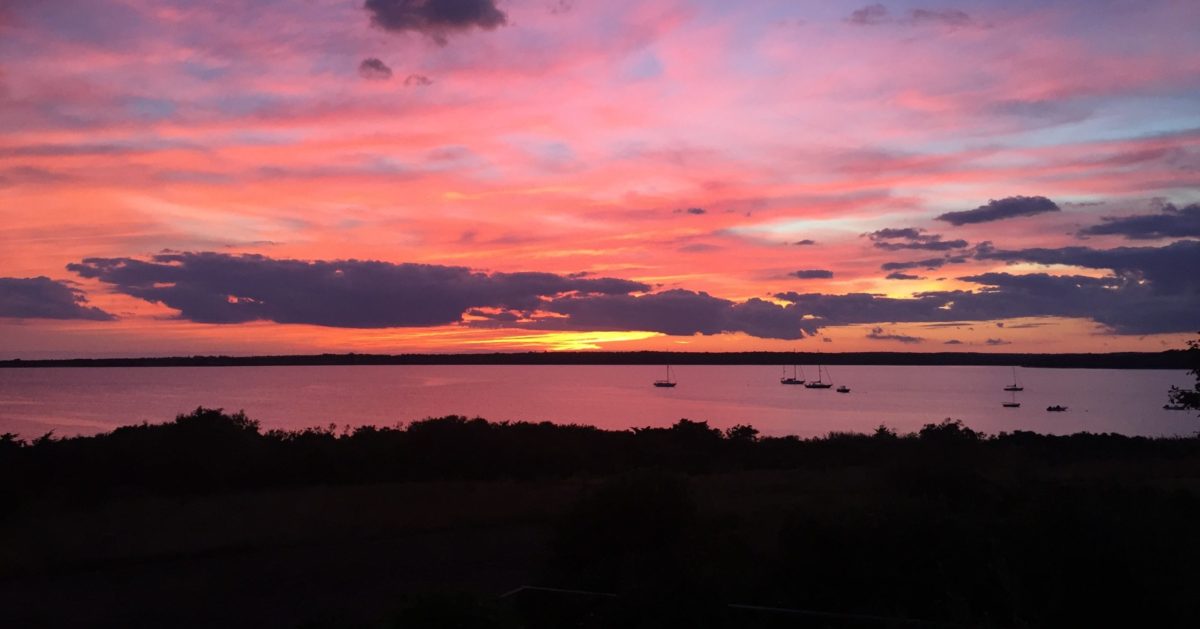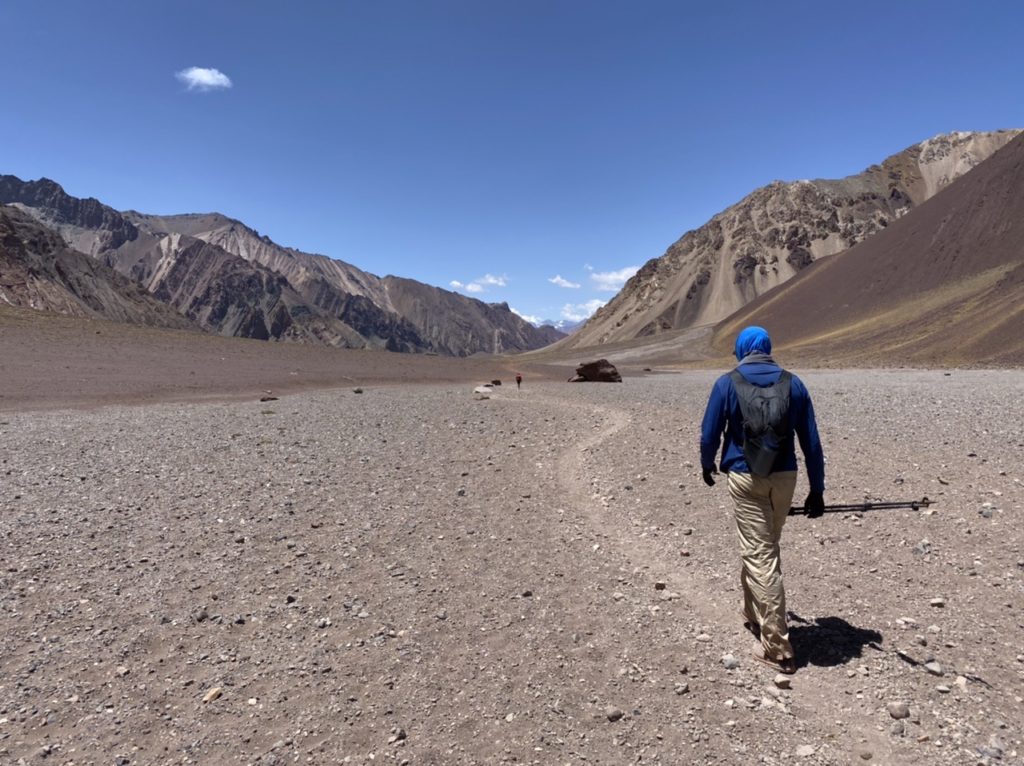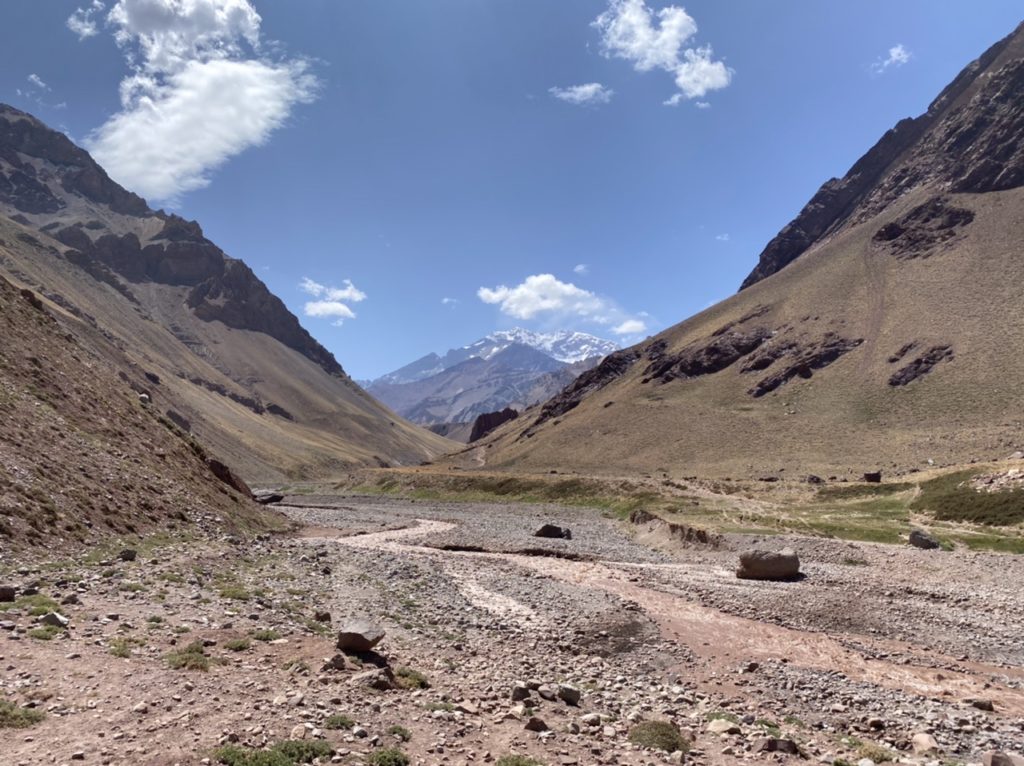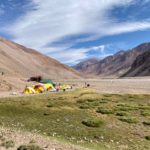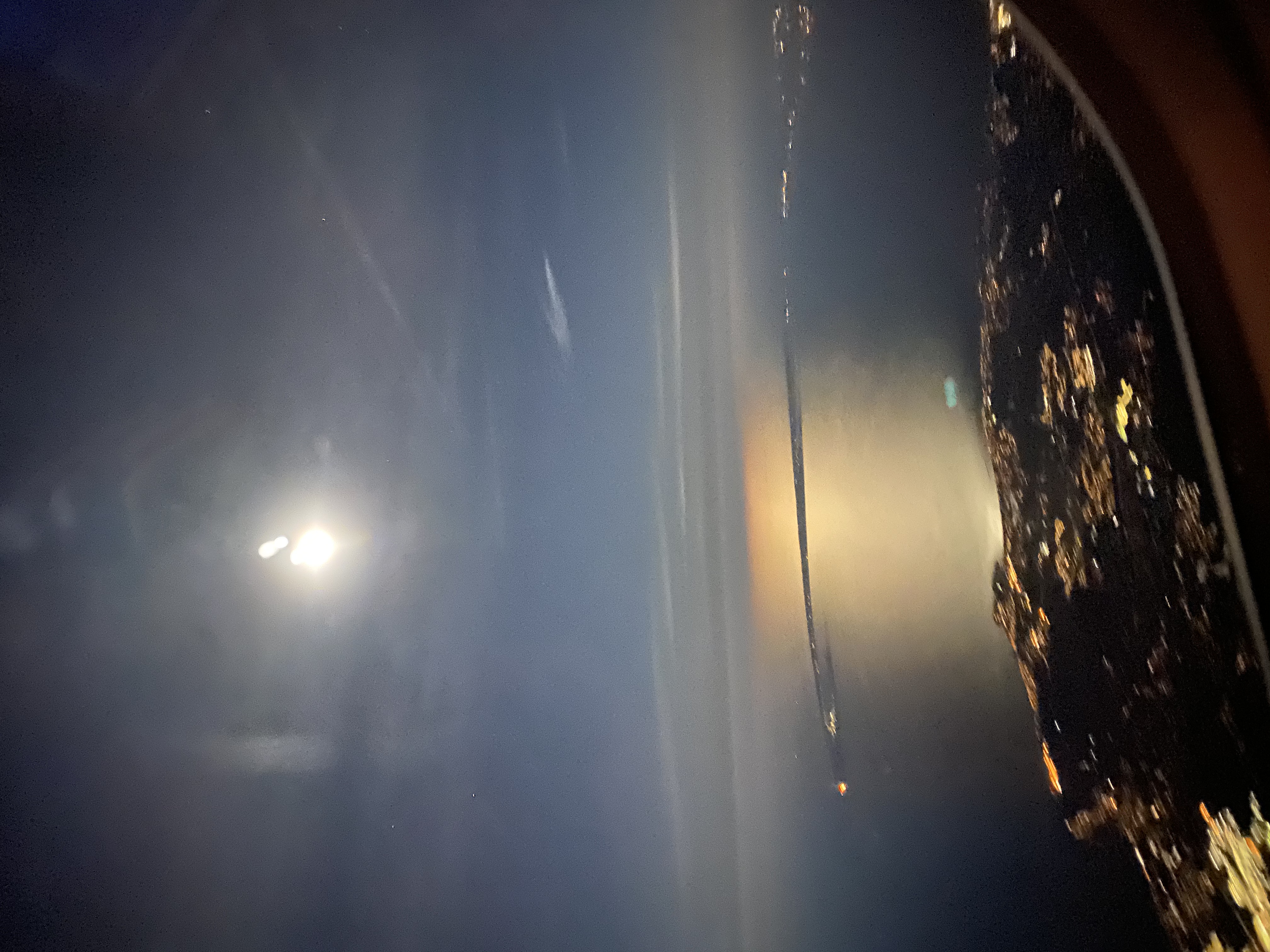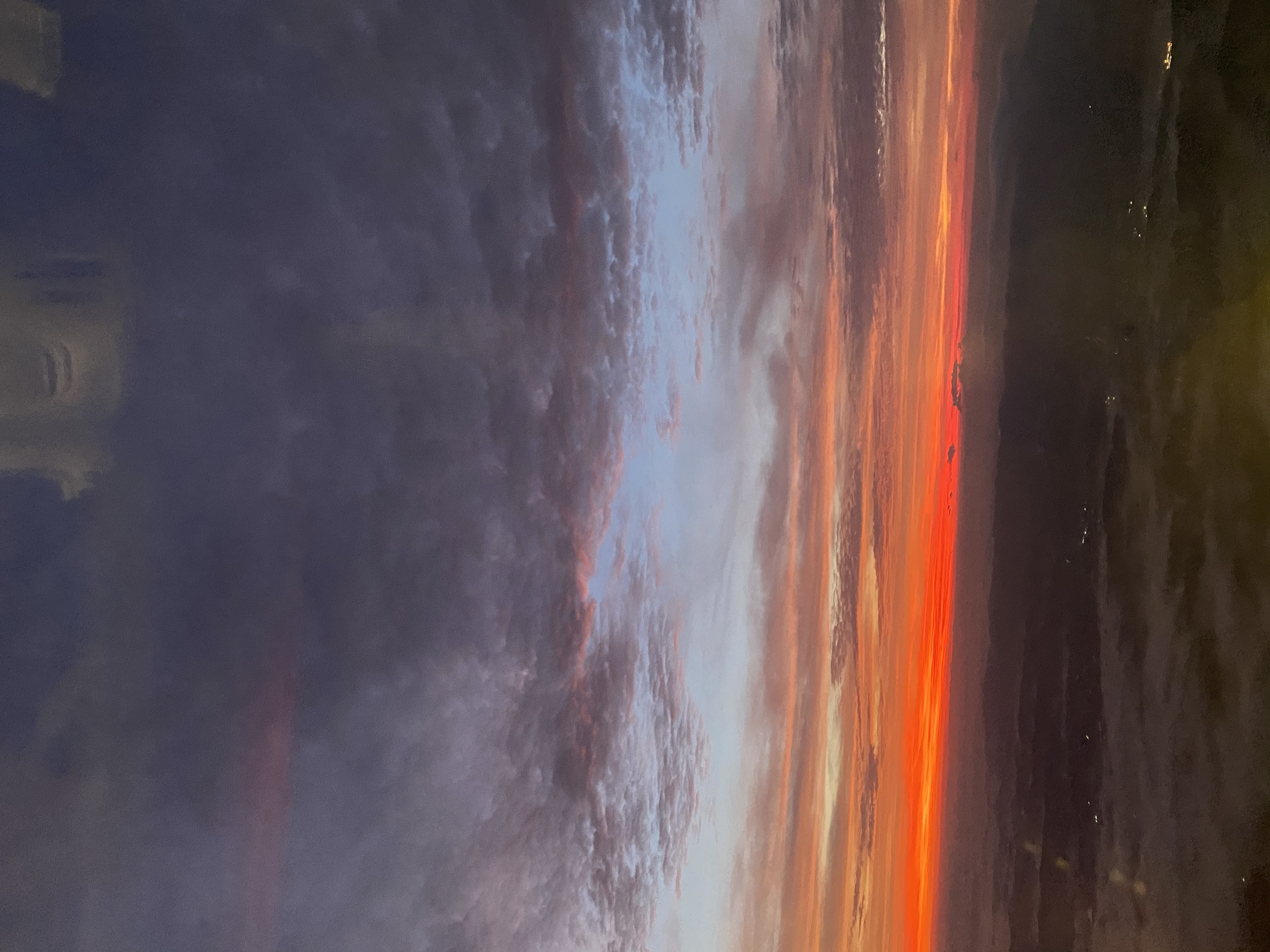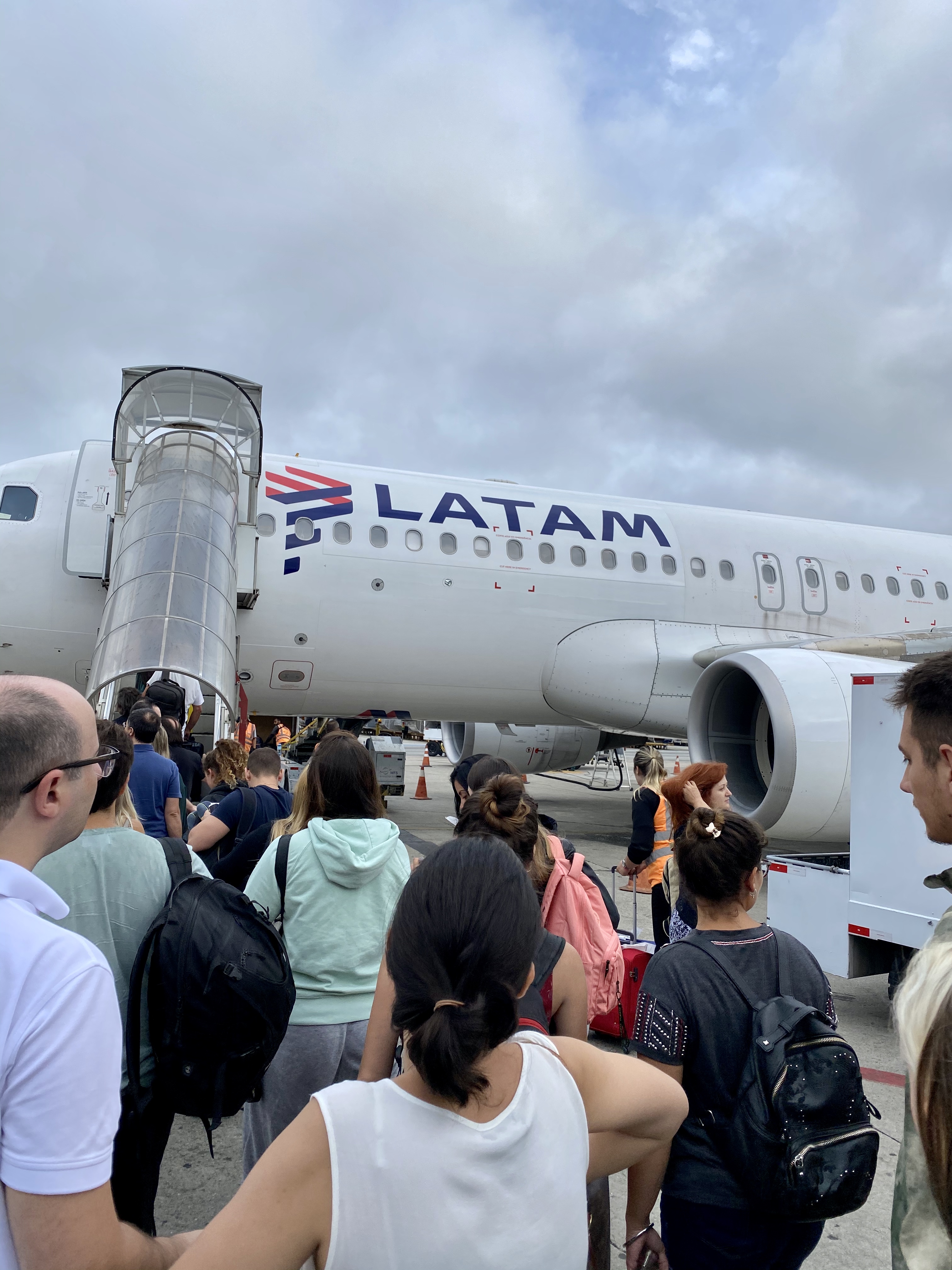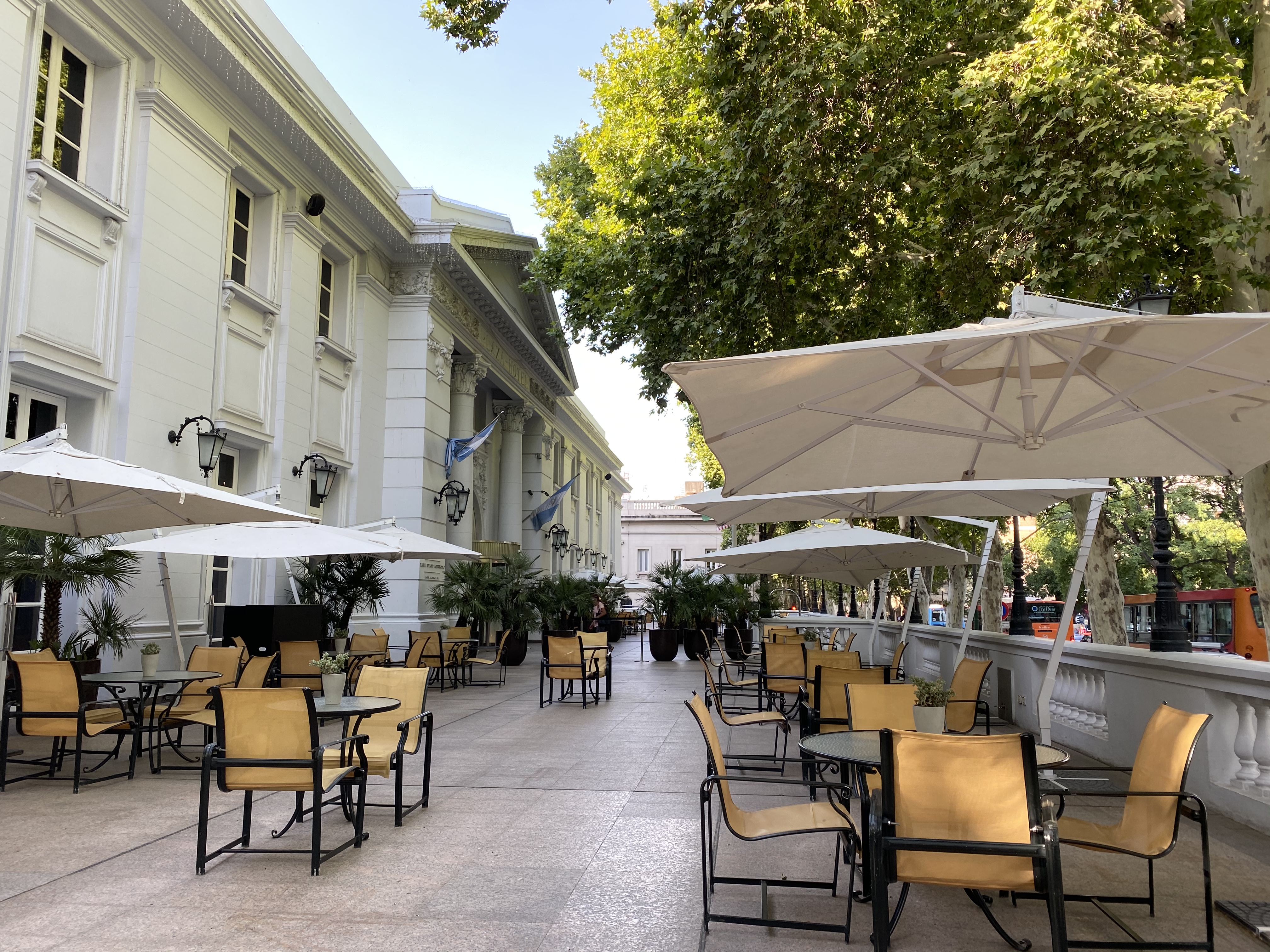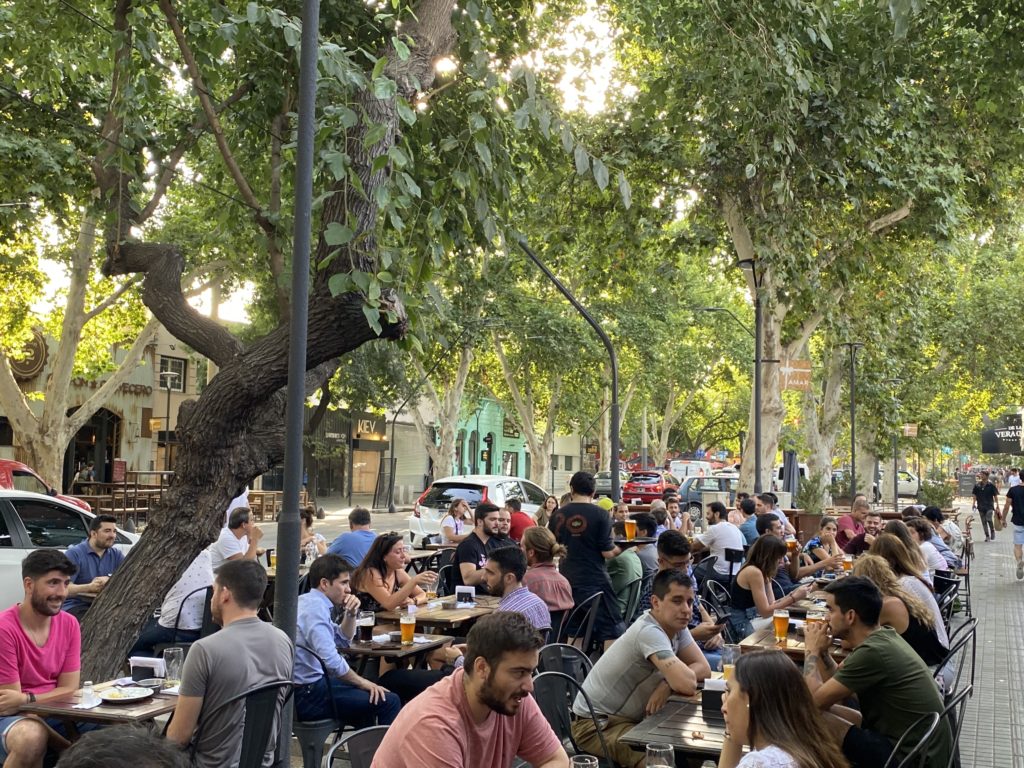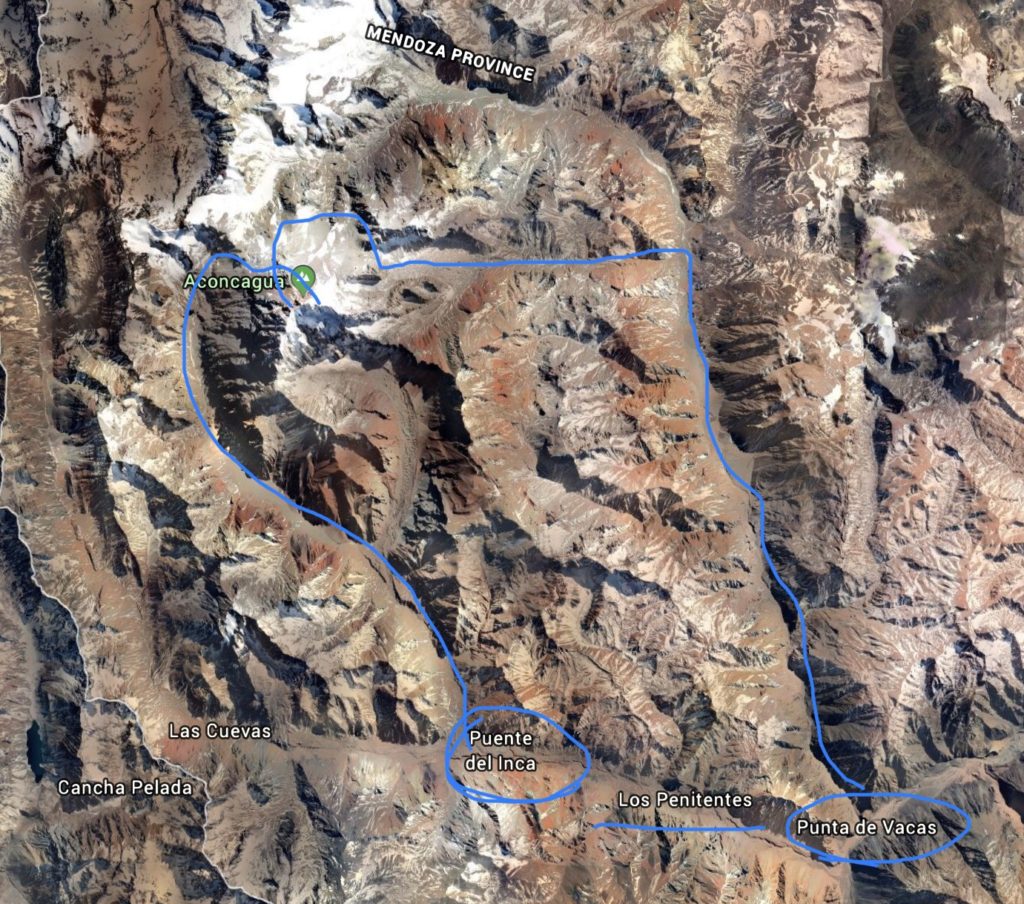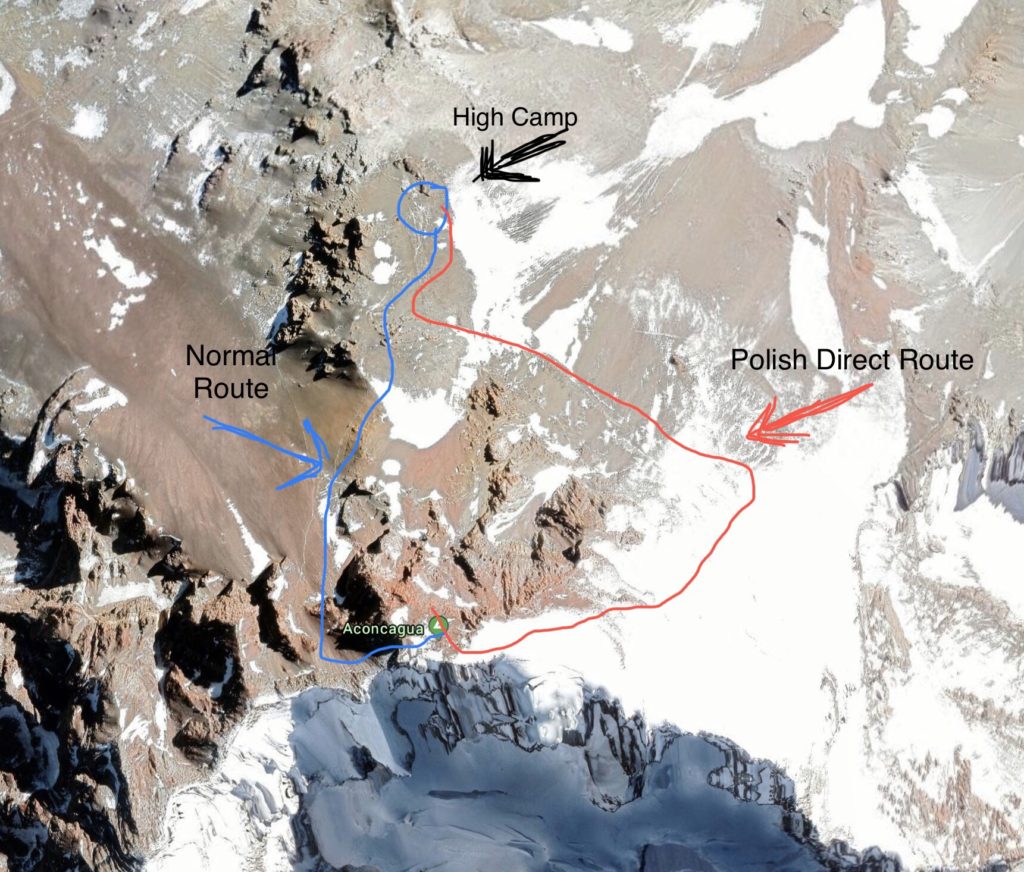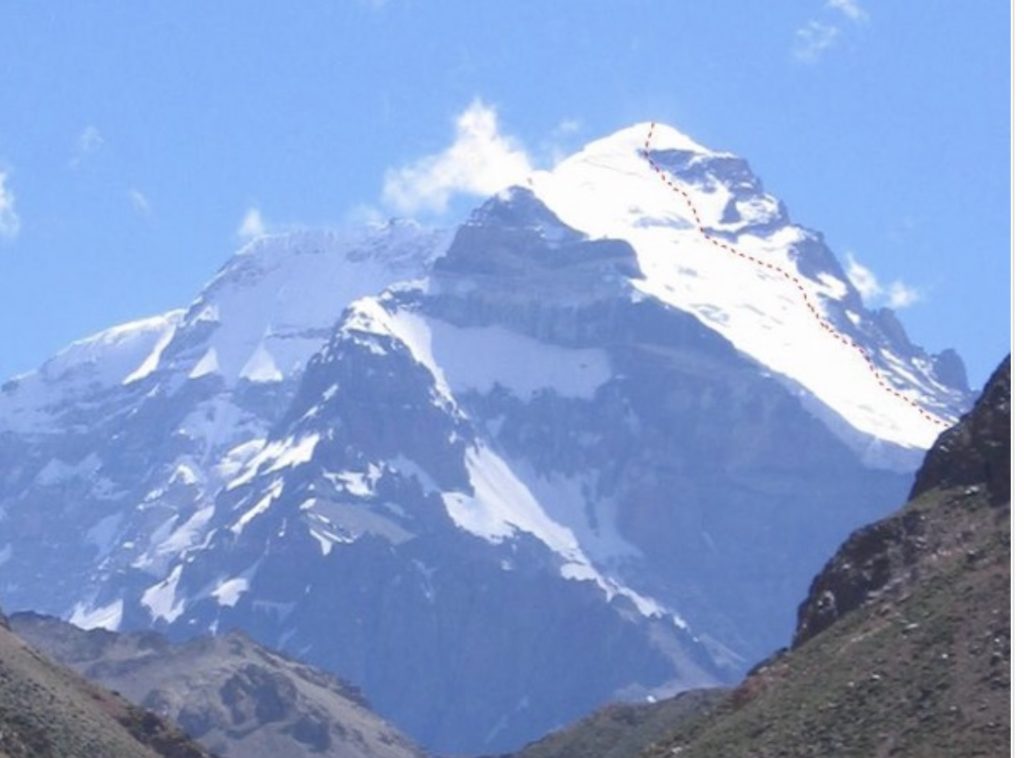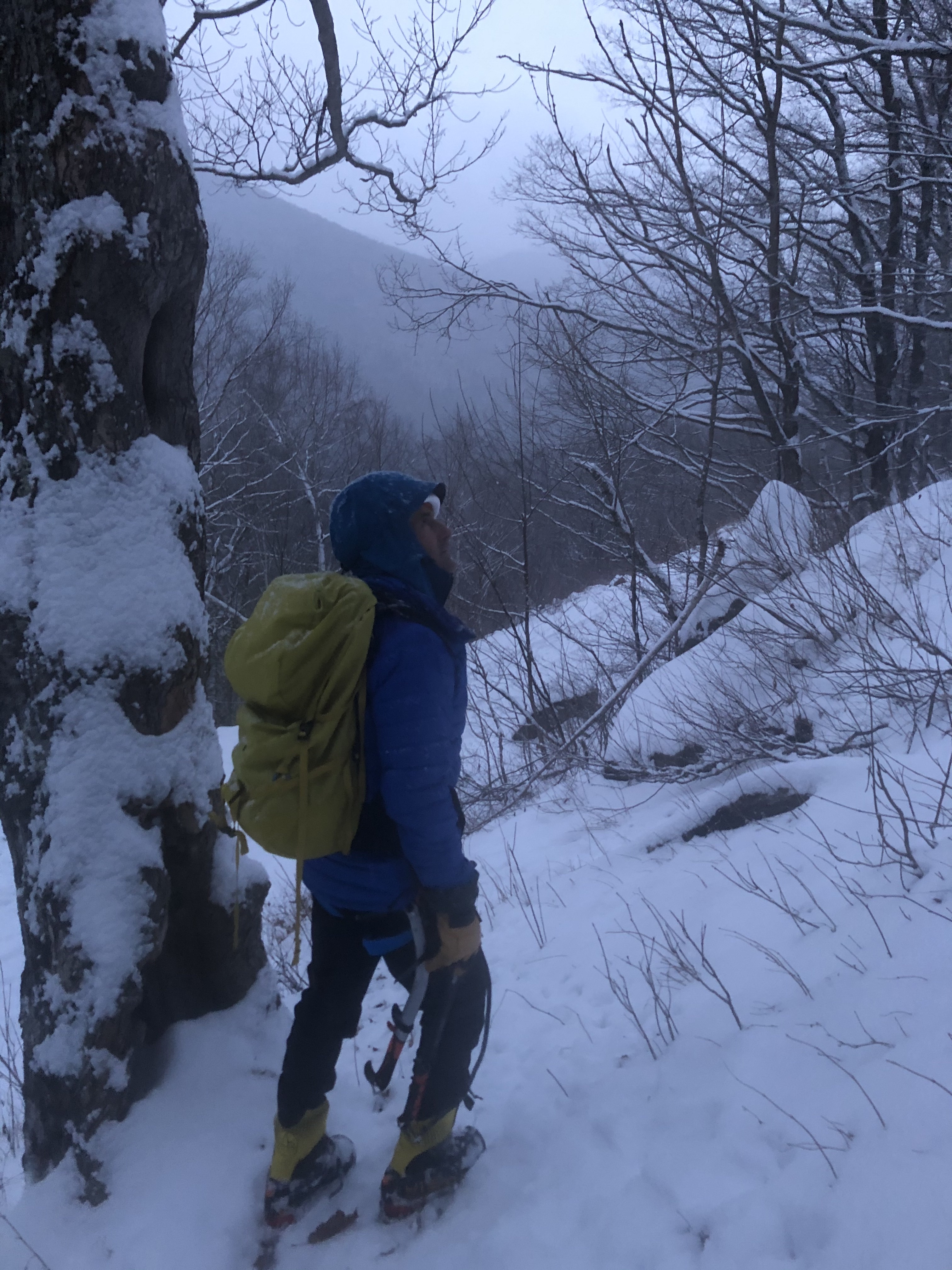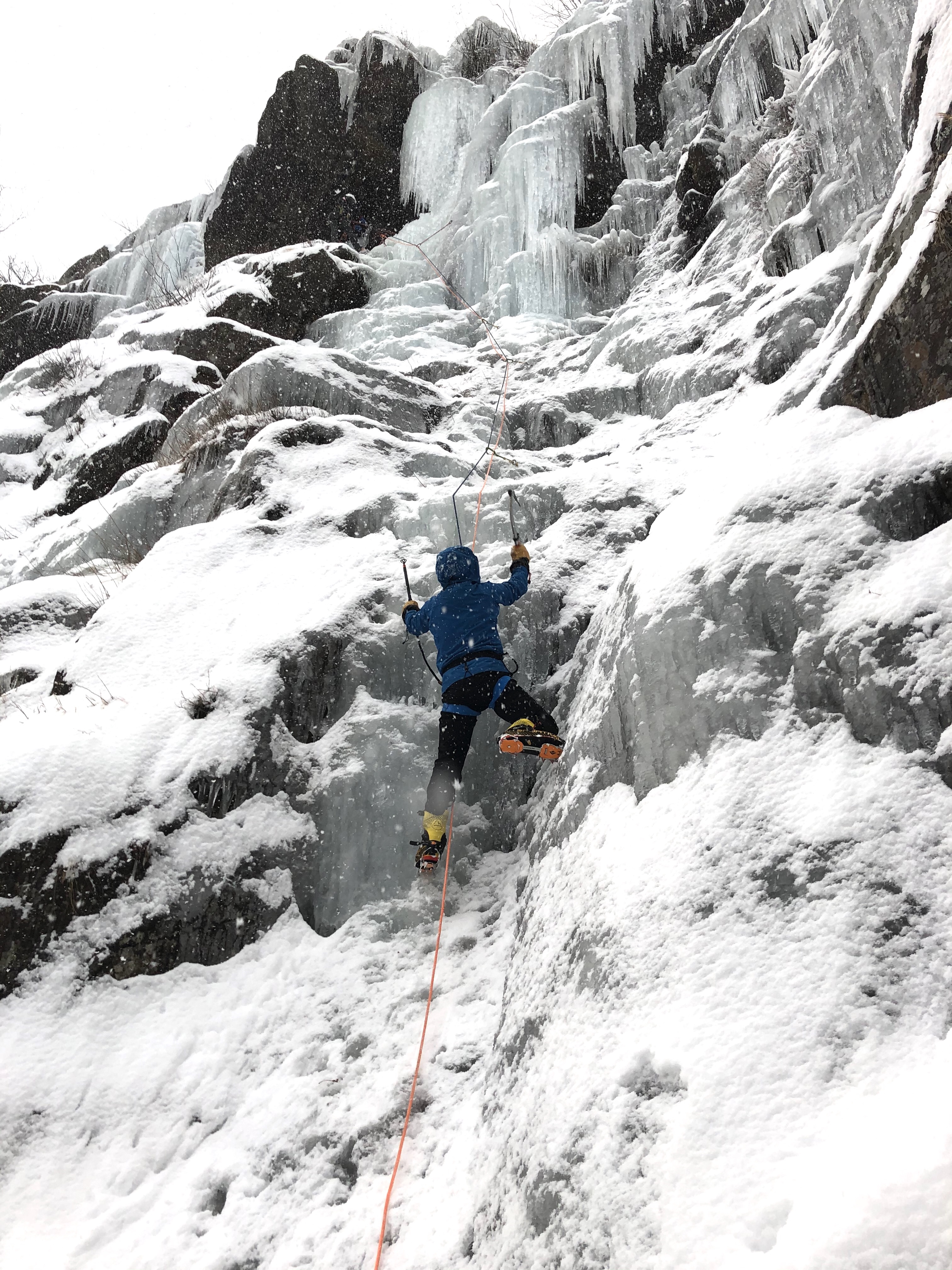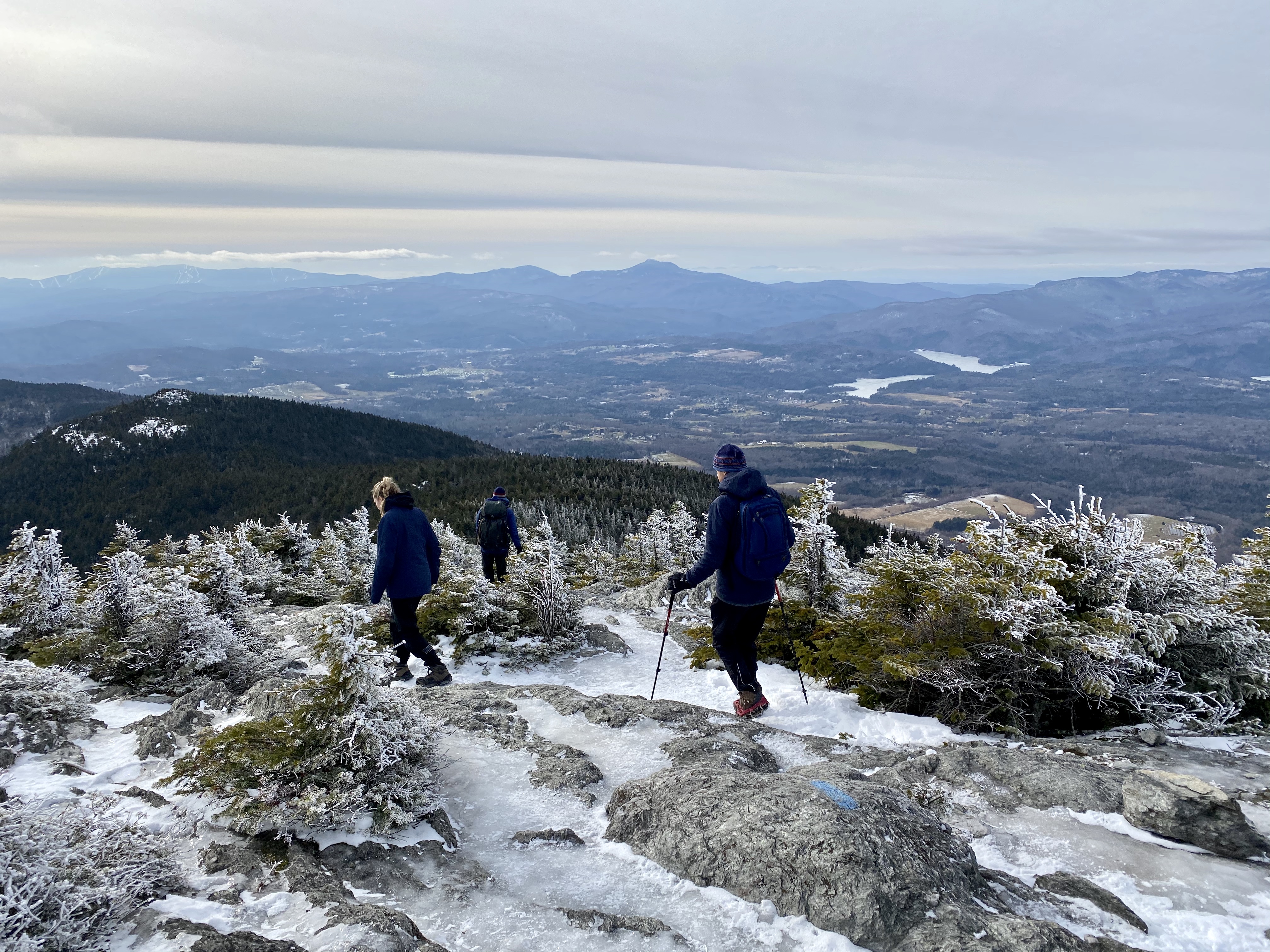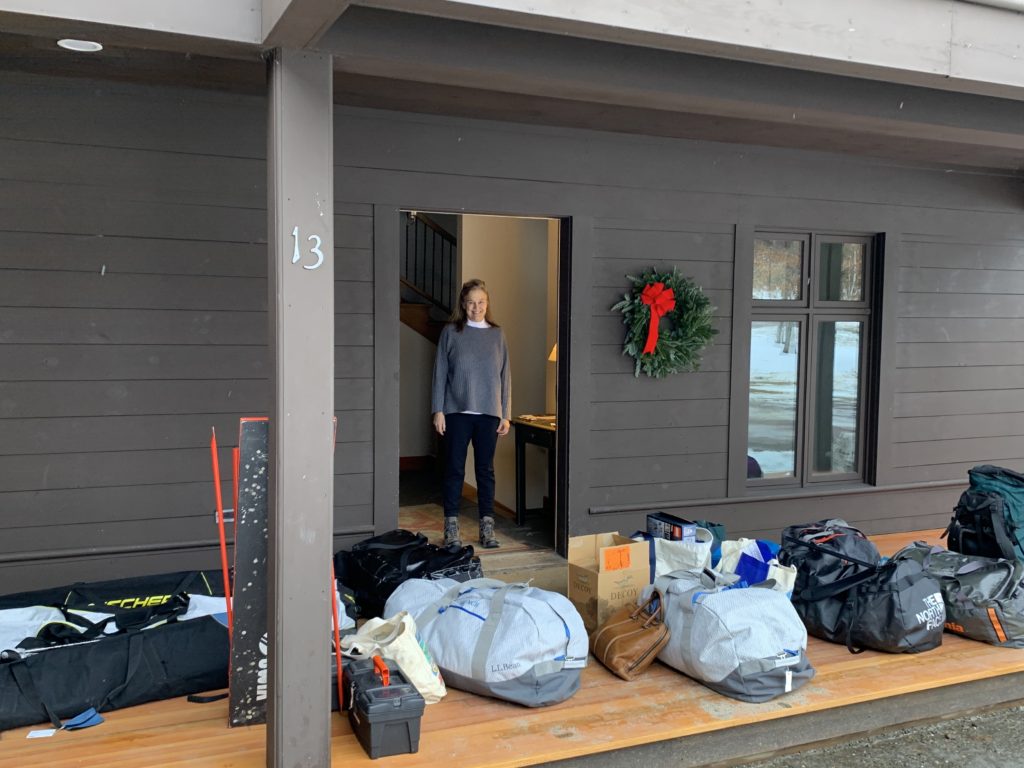Since I last posted from base camp, I have climbed to the summit of Aconcagua, (At 22,837 feet, the highest point outside of the Himalayas), descended to Plaza de Mulas base camp on the other side of the mountain, and trekked the 18 miles back out to civilization. I got back to Mendoza late last night. As anticipated, it all was exhilarating and deeply satisfying, but played out differently than expected on some dimensions.
I experienced the past ten days in several stages:
Stage 1: Moving to Camp One and proving myself
Our first priority above base camp was moving loads and ourselves up to Camp One at 16,000 feet. The climb is 2,600 vertical feet, with a steep start up a canyon, a more gradual middle section through a glacial moraine, then a super steep scree headwall up to a shelf in a valley where Camp One sits. This is all hiking as opposed to technical climbing, but physically challenging as your body struggles to get used to the increased altitude. Above it all looms the Polish Glacier, which I still hoped to climb if conditions allowed. Here is a photo looking down on Camp One as I performed my nightly tooth brushing routine:
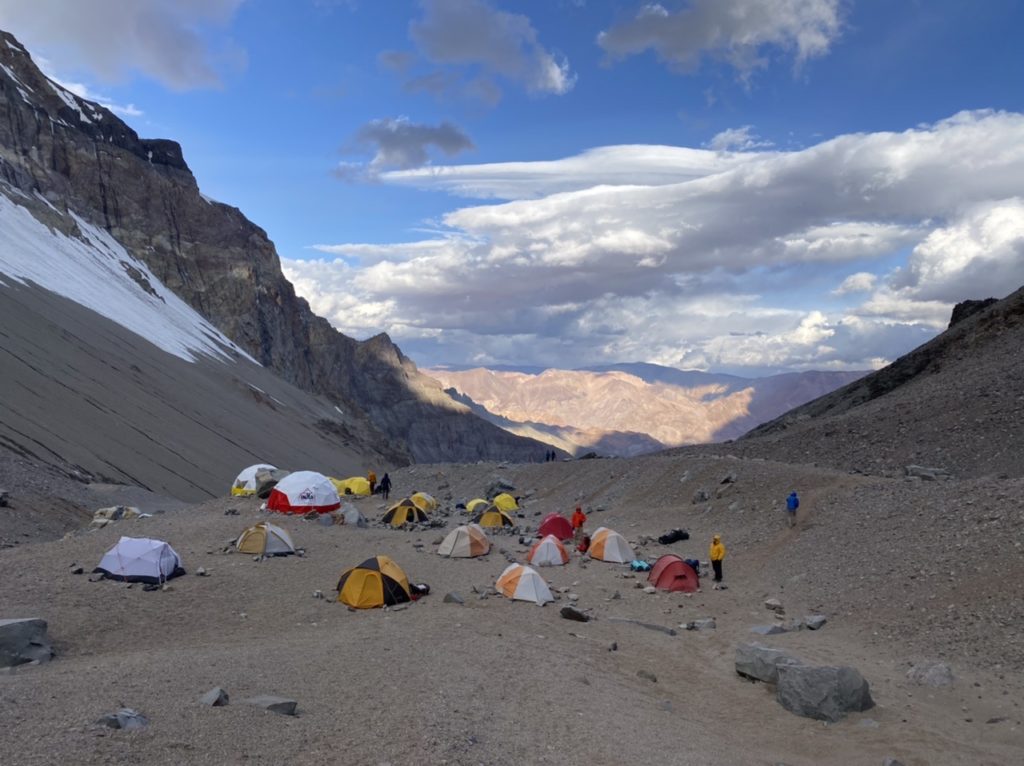
As we carried loads, it was clear that the guides were trying to figure out how strong I was, given my desire to take on the Polish Glacier, (and, no doubt, given the fact that I am 60 years old). On the first day, Rolo, the head guide, told me that Sebastian, the guide I had hired to climb the glacier, was about to climb ahead of the group very quickly to Camp One, and that I should see if I could stick with him. This was not the way I had been planning to approach moving my 50 pound load up the mountain that day, but clearly a hurdle I had to clear. So the test was on.
Sebastian took off like a rocket. I got right behind him and tried to match him step for step. I was immediately straining. Like the start of a cross country ski or running race where you go out with the leaders and aren’t sure if you can hang on. 15 minutes in, I was red lining and wasn’t sure I could do it. 30 minutes in, I began to think maybe I could. 90 minutes in, as we approached the scree headwall, I told myself “dig deep and don’t blow this”. The headwall was brutal and I was totally maxed out, but I hung on. Then we crested the ridge. I could see Camp One not far above us, and a feeling of elation started to build.
It normally takes climbers 5-6 hours to move from base camp to camp one. The rest of our group ended up doing it in 5 1/2. Sebastian and I did it in 3 1/2. When we got there, Sebastian gave me a huge hug and said “Wow, you are super strong. Well done!” I had earned myself a pass for the Polish Glacier. He then headed down the mountain to help one of the slower members of our group. I sat in the sun at Camp One, ate and drank, waited for the rest of the group to arrive, and felt ridiculously satisfied.
Here is a photo taken over Sebastian’s back during my “test”, as we headed up the canyon toward Camp One with the Polish Glacier above us.
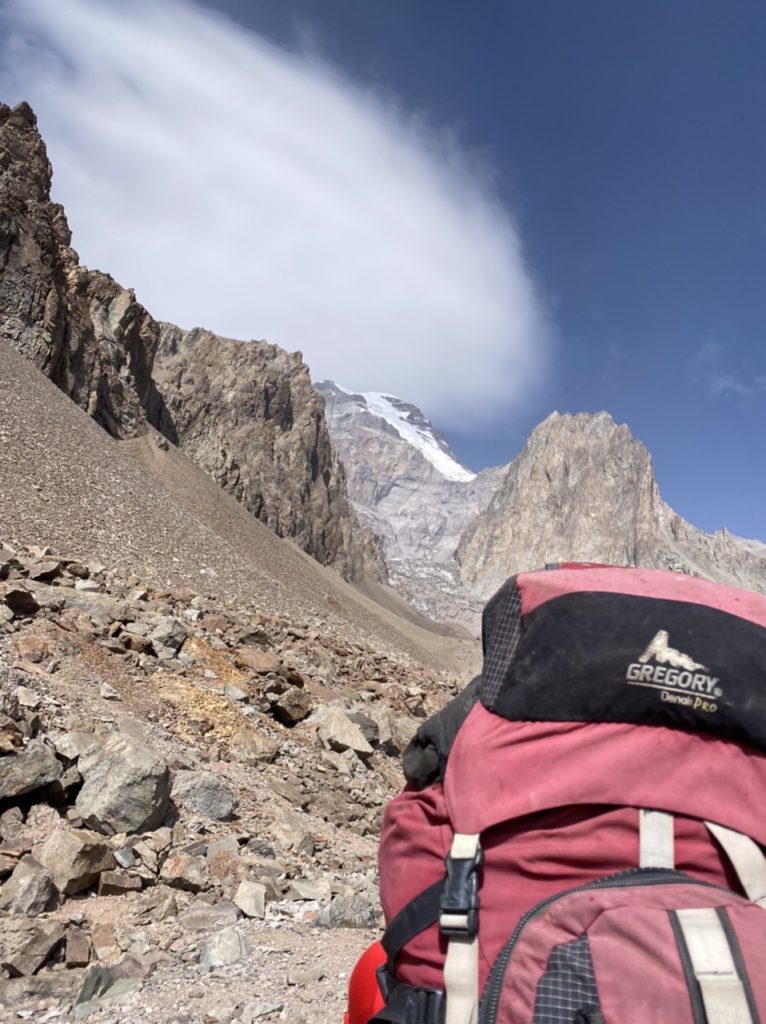
I describe all this not to pound my chest, (although I admit to doing so ), but because sitting in the sun at Camp One, feeling great about passing the test, was a defining moment of “Stage One”for me, and stands out even more so in the face of how subsequent stages evolved.
Stage 2: Route decision and “re-set”
From Camp One we followed the same process of carrying loads higher on the mountain, then moving ourselves up to the next camp. Between Camp One and Camp Two, things start opening up and you begin to get good views of the upper mountain
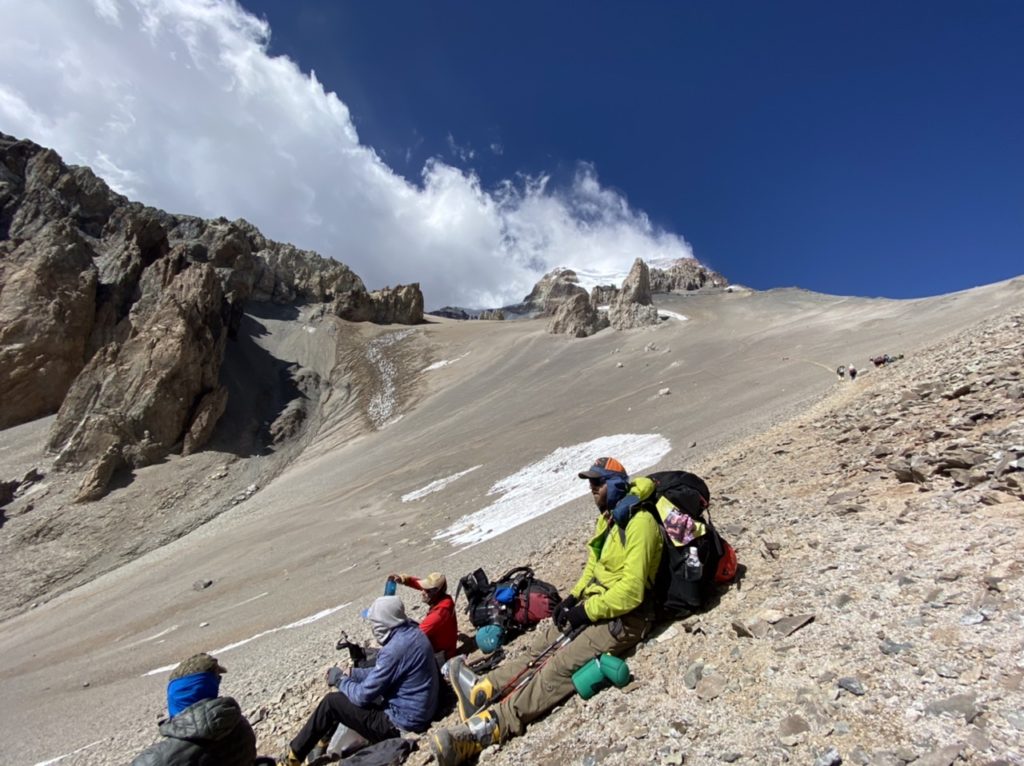
Between Camp 1 and Camp 2 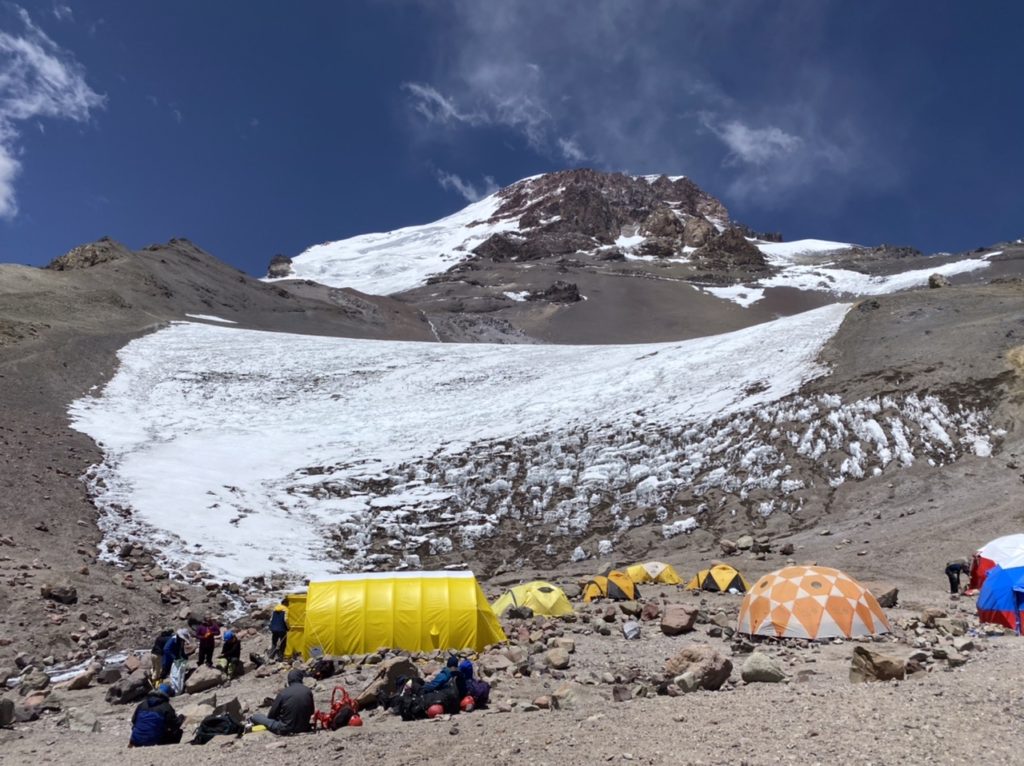
Camp 2: 18,000 feet
We also began to get good views of the Polish Glacier. As I mentioned in a previous post, there are good years to climb the glacier and bad years, all dependent on the conditions of the route. Unfortunately, this has turned out to be a bad year. After record low snowfall throughout the winter, the past month on Aconcagua has been as warm as anyone can remember. Snowfields and glaciers are receding , and every day on the mountain we saw and heard avalanches at a frequency well above normal. The Polish Glacier, along with many of the other technical climbing routes, is suffering. The bottom half is severely melted out, with large fields of ice pinnacles called “penitentes” making travel really slow and tiring. Higher on the route, more crevasses are exposed and there is increased avalanche risk.
The guides were great; saying I was strong enough to give it a shot and the decision was up to me. While I felt I had a reasonable chance of summiting, I said all along that I would not take on significant increased levels of risk. Mountaineering is a lot about assessing risk and making the right decisions, and unfortunately I knew what the right decision was. So, with a heavy heart I abandoned my hope of climbing The Polish Glacier and set my sites on Plan B – summiting on the Normal Route. For those of you who recall my route sketches in an earlier post: instead of “red line up, blue line down”, I would go with “blue line up, blue line down”.
While I knew all along this shift might happen, It still involved a bit of a “mental reset”. A big piece of climbing Aconcagua for me was the idea of parting ways with the other groups on the mountain and doing my own thing, on a more challenging route. For better or worse, I have often derived satisfaction from breaking from the mainstream, (even if in reality I am less out of the mainstream than I think). In the case of Aconcagua, part of my internal narrative had been something like: “ I am going to rejoice in climbing this cool mountain, but also do it in a different way than most of the other people who come here. This is going to make it an extra special experience, and in a way confirm to myself that I am the kind of climber who deserves to be on Everest this spring”.
Now my internal narrative became something like: “While I am disappointed not to be climbing the Polish Glacier, I am proud of myself for making the right decision, and I have a great climb still to look forward to. Also, having come to Aconcagua physically and mentally ready for the Polish Direct, I can now relax a bit and enjoy fully every step of the Normal Route, without worrying about something that is overly challenging.”
With this “re-set” also came a renewed focus on being part of the group of six other climbers I had been with so far. Rather than splitting off from them, I was now going to take on the summit with them. It was an interesting group, and I liked them all. Joey and Andrew – high school buddies from Oregon in their late thirties who had been training hard for this, Bill and Heike – a couple from the New York area who got excited about mountain climbing after Bill went up Kilimanjaro, Lewis – who had been dreaming of climbing a big mountain for a long while and picked Aconcagua because “ it is way less likely to kill you than Everest and the others ”, and Karen – an avid outdoors woman from Alaska who at age 72 (!) was attempting to be the oldest woman to summit Aconcagua.
A lot has been written about the dynamics of commercially guided climbing groups and the explosion in their popularity. I’ll save most of my thoughts on this for another time, other than to say three things: 1) It is indeed striking how this dynamic has opened up the world’s great mountains to people who a decade or two ago wouldn’t have been there, 2) Whenever I start to feel a bit “holier than thou”, I remind myself that this dynamic includes me, and 3) Every time I have been a part of one of these groups, I have been struck by how much I like and respect all of the individuals involved, and how powerful a shared experience it is.
So, “stage two” ended with me heading to High Camp with our group of seven climbers, looking forward to a redefined but still exciting summit challenge.
Stage 3: High Camp and Summit Day
We took three days moving from Camp Two to High Camp, two load carry/climbing days and one much appreciated rest day for acclimatization. You really start feeling like you are on a big mountain, and the views out over the surrounding peaks are spectacular. The air also starts to feel really thin.
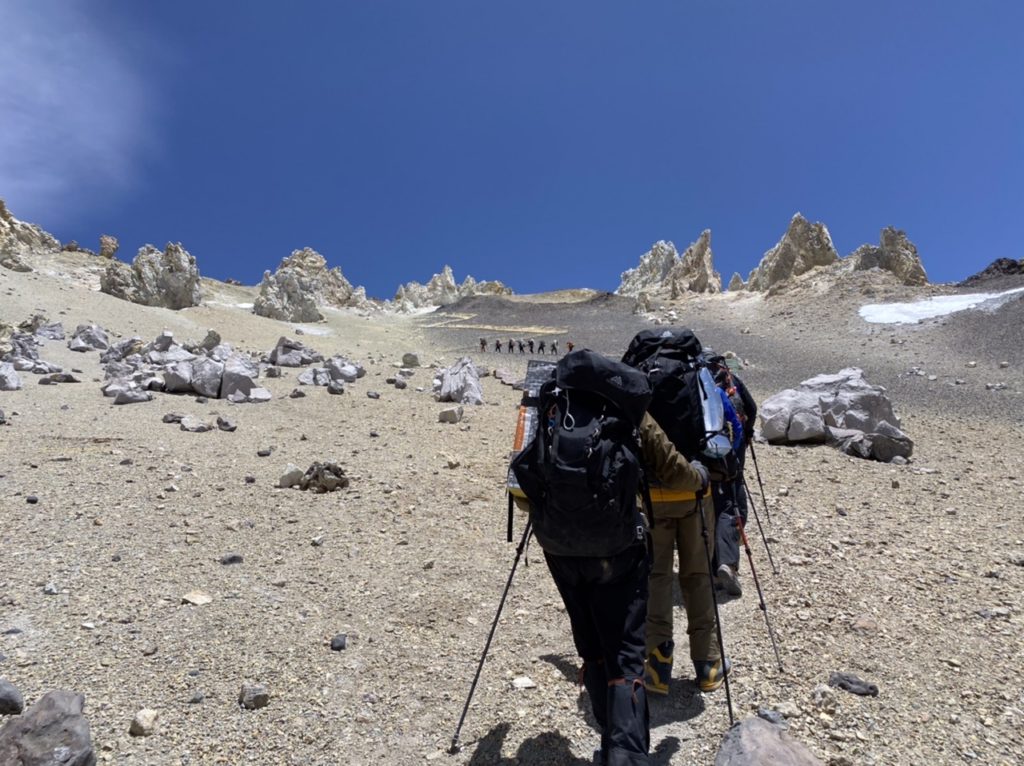
Heading to High Camp 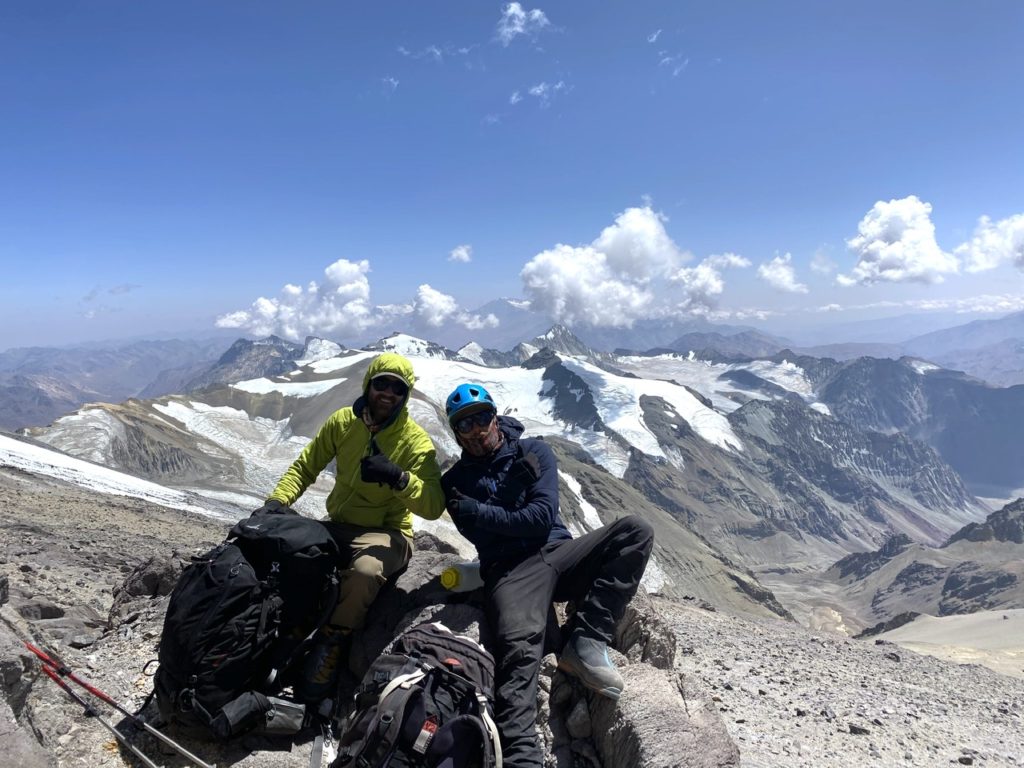
Great views
High Camp, named “Camp Cholera”, sits at 19,500 feet. This is where the climbing routes up the east and west side of the mountain merge and share a common path to the summit. It is a windy, bleak place, with everybody up there worried about how they are handling the altitude and focused on preparing for their summit attempts. As you can see from this photo, we had plenty of company .
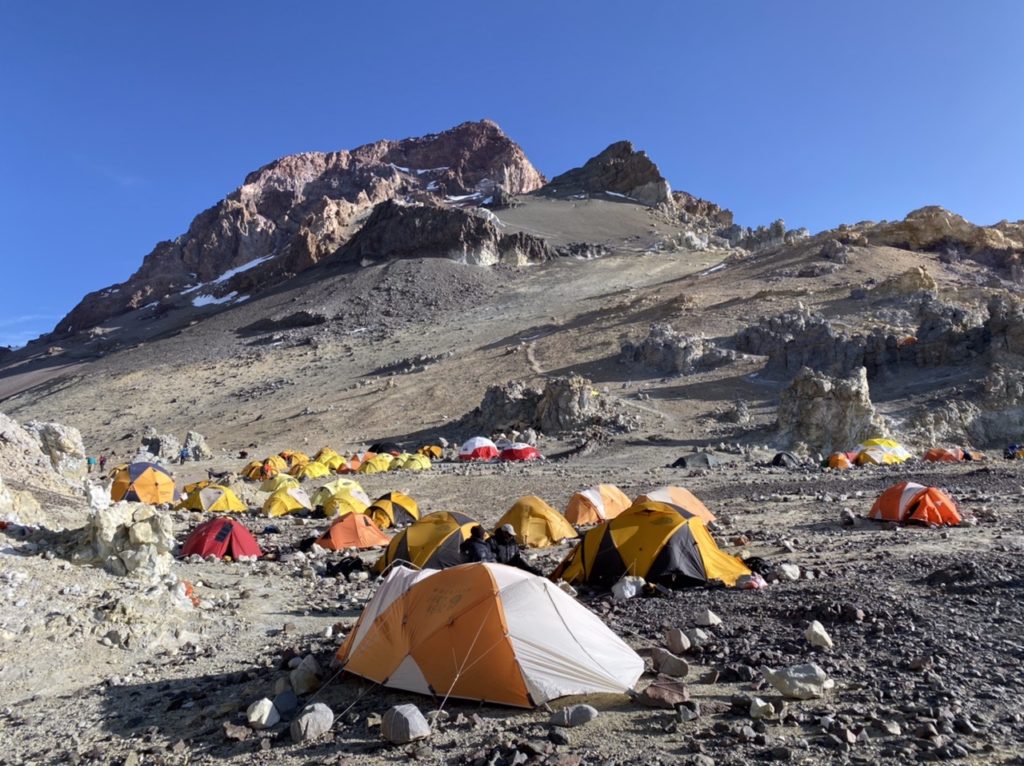
I couldn’t have been more pleased with how I was feeling. All along, I had been adapting well to the altitude; sleeping soundly, maintaining an appetite, and avoiding the headaches that plague most everybody. Despite carrying heavier loads than the other group members, I found myself easily outpacing them. Putting the Polish Glacier behind me had also let me maintain a “quietly confident” mindset as summit day approached. I knew I had it pretty much nailed, and was looking forward to it far more than worrying about it.
As on all large mountains, weather is a critical factor on Aconcagua. Punishing winds can make the summit unapproachable for several days at a time, so everyone plans their attempts around the weather windows. Our target summit day was Saturday, Jan 25 and the weather cooperated perfectly, serving up a clear day with relatively low winds .
The night before, we got our summit gear organized, forced down as much freeze dried food as our altitude influenced appetites would let us, and crawled into our sleeping bags for a short night’s sleep. At this point, Bill, Heike, and Karen had decided that 19,500 feet was high enough for them and they would sit out the summit attempt. This is a very common decision on Aconcagua , as the elevation of high camp is roughly that of the summit of Kilimanjaro and not far off of the summit of Denali.
We were up at 4:00am, with a 30 mph wind rattling the tents and making the below zero temperatures really bite. After dealing with the gruesomeness of evacuating my bowels so I didn’t have to do it later amid more challenging conditions , (apologies for this detail, but some of these things are what is least pleasant about high altitude climbing ), I found my fellow climbers and three guides standing amid the tents in a glow of headlamps. We started climbing at 5:00am. Shortly thereafter, Lewis decided it wasn’t his day and turned around, so our group of seven was down to three: Joey, Andrew, and me.
We climbed into the dark for a couple of hours, following a stream of headlamps from other climbers. Every time I looked up, I dreaded it, because the lights were rising so steeply above us. The Normal Route isn’t technical, but it is relentlessly upward at altitudes over 20,000 feet. Somewhere around a cleft in the ridge called “Independencia”, the sun rose. As we kept climbing , we were treated to the sight of the morning sun illuminating the path above us and the terrain below.
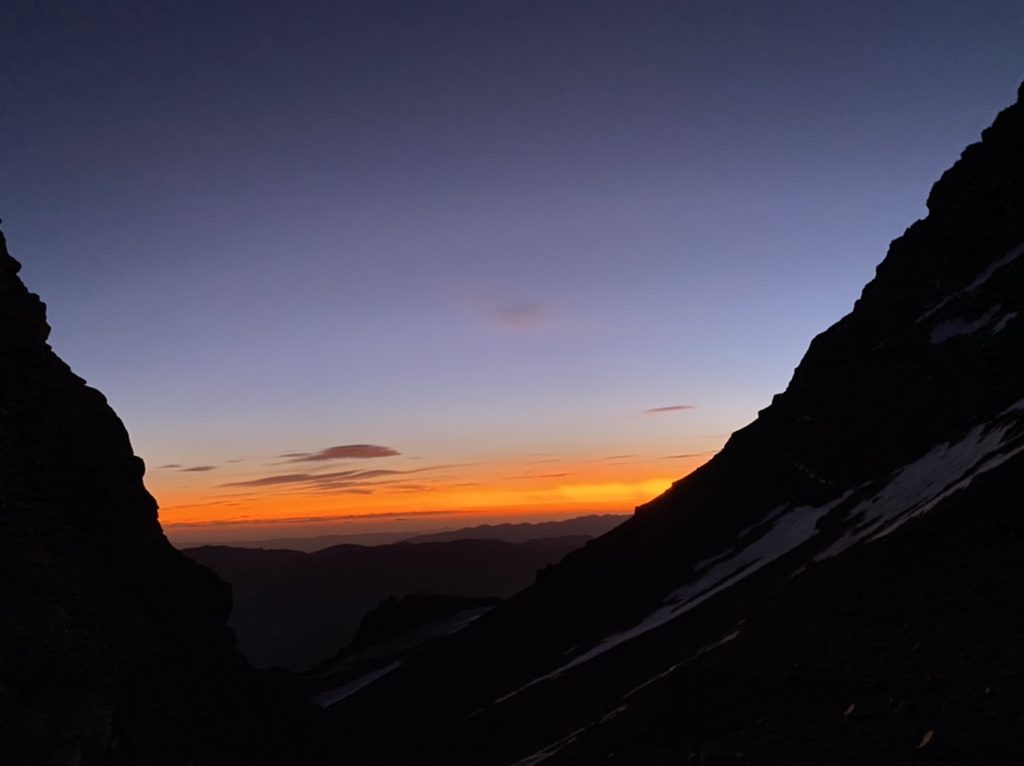
Sunrise at Independencia 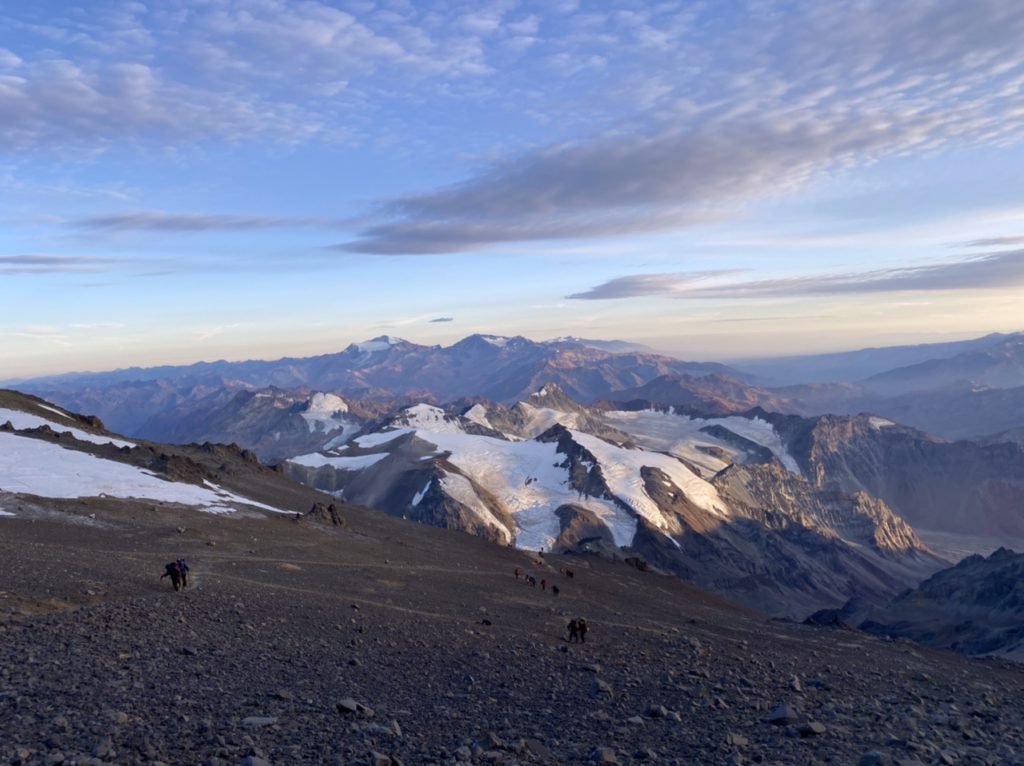
Above Independencia
At this point, my implicit “Aconcagua narrative “ shifted yet again. Simply put: Aconcagua kicked my ass. Out of nowhere, the altitude suddenly started to effect me. What I had been viewing as straightforward fallback hike to the summit morphed into a highly challenging hurt dance.
Andrew had fallen behind at this point, (he later turned around, quite close to the summit, at a place called “The Cave”). So it was Joey, lead guide Rolo, and me pushing upward. It got more and more painful, and I had more and more of the “dreamlike” moments that I have experienced on other tall mountains, but always been able to shake off. In these moments, it is as if I am half there in the present and half living in a dream. At one point, I had the horrible realization that, if it got much worse, I would have to turn around. That would be a totally different ending to the “no problem- I’ve got this- Plan B summit” storyline.
Fortunately, I was able to push through. The last 800 feet, as anyone who has climbed Aconcagua will tell you, is absolutely brutal. You have to navigate a steep, scree filled couloir called the “Canaleta” that makes upward progress super challenging while your lungs are screaming for air.
It wasn’t pretty, and took quite a bit longer than I expected, but I got there. I was feeling good enough to enjoy my time on the summit, and managed to get a summit photo so I could remember that I had actually been there and it wasn’t a dream.
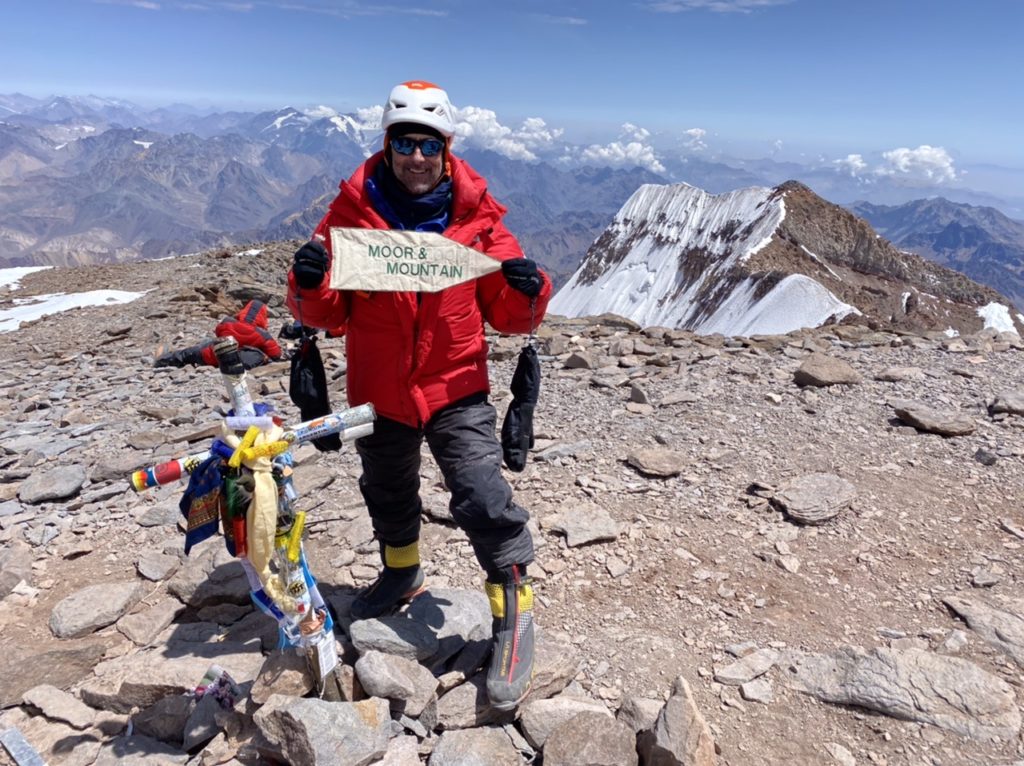
Aconcagua summit: 22,837 feet
The descent was fine, although I was weak enough that I had to be really careful about where I put my feet to make sure I didn’t fall. I have never had to do this before when climbing with a guide, but I told Rolo: “I am kind of messed up here, so please keep an eye on me in the tricky parts; I don’t want to do something stupid”.
The lower we got, the better things got. We were back to the tents at high camp around 7:00pm and I crashed. The next day we descended over 5,000 vertical feet to the base camp on the west side of the mountain named “Plaza de Mulas”. As I did all along, I refused to engage the support of high altitude porters to carry my load, so my pack weighed over fifty pounds and my legs were shot by the time I got down to base camp. (Over the past decade, a significant number of climbers on the mountain have started paying for help with their loads. Nothing wrong with this per se, and it has created an attractive livelihood for a group of young climbers and future guides, but it’s not for me. At least not yet).
Here is a photo of my tent at Plaza de Mulas base camp, which I hobbled into after descending from Camp Cholera:
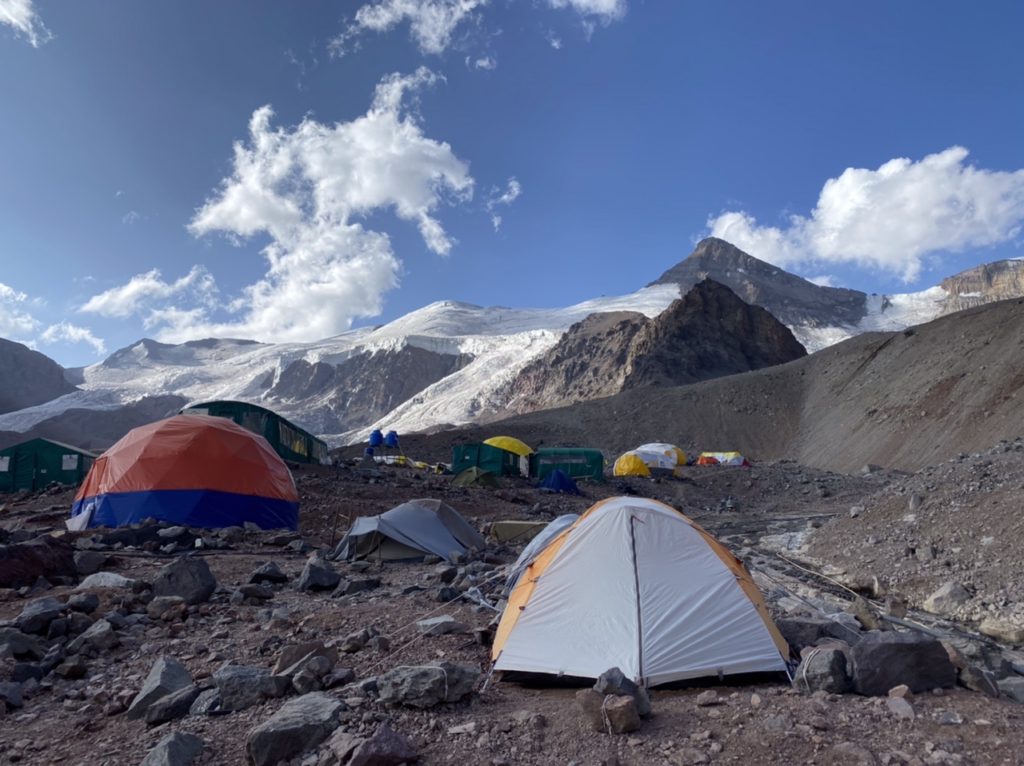
One thing is clear: given how the altitude effected me above 20,000 feet, I would have really struggled on the Polish Glacier.
The next day, (yesterday), we trekked 18 miles through desolate, striking river valleys back out to civilization. I was again struck by what a massive amount of wilderness the Aconcagua Provincial Park is, and what a great job the Argentinian government is doing to preserve it.
Andrew and I arrived at the road a couple of hours ahead of the others. Our circumnavigation of Aconcagua was complete.
We got a ride to Penitentes, the forlorn, out of season ski village on the main road from where we started over two weeks ago. The van was full of climbers. The guy driving the van was a twenty-something Argentinian climber dude with a slick puffy down jacket and a pony tail. He was playing Pink Floyd on the stereo and, when one of the other passengers said he liked it, he cranked the volume. The music sounded really great. I stretched my tired legs out under the seat in front of me, looked out the window at the vast emptiness of ridges and canyons, and smiled.
At the faded hotel in Penitentes, I paid the equivalent $70 for a room so I could shower while waiting for the others. Then I realized that I really wanted to shave and needed a razor. The guy behind the desk directed me to a rusted trailer a few hundred meters up the road. I hobbled there, walked through a wire fence and past a couple of tired dogs, and found an old man with a long beard and overalls sitting outside in a plastic chair. With hand gestures, I explained what I was after. He went inside the trailer, got a key, took me to a small hut behind the trailer, and welcomed me to the Pentitentes convenience store. I motioned “shave” and he dug two disposable razors off a dusty shelf. I motioned “underarms “ and he produced a stick of deodorant. Then I hobbled back by the dogs, through the fence, and to the hotel where I had one of the best showers of my life.
A couple of hours later, the rest of the group arrived, as well as our gear on the mules from base camp. We hopped in the van and headed out of the mountains to back to Mendoza. Here is a photo of the main drag in Penitentes that we left behind.
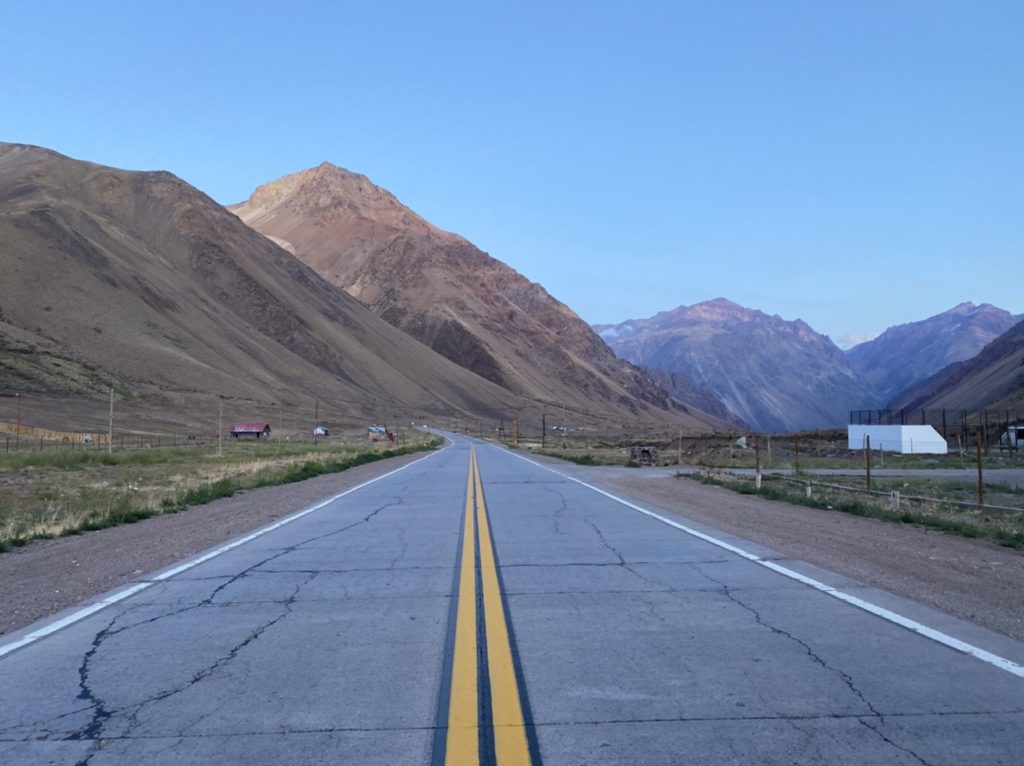
It was a great climb, but not all that I expected. I experienced some of the intense challenge, moments of beauty, and feelings of deep satisfaction that I have long sought and treasured in the mountains. At the same time, I learned that I was, consciously or unconsciously, assuming a personal storyline for an experience that didn’t always hold up. As much as I was glad to be on the mountain, I am really glad to be off of it and flying home tomorrow.
In most ways, this doesn’t change my feelings and excitement about heading off to Everest at the end of March. But I do so more sober in my own expectations, and more wary of assuming I know the storyline in advance. Between now and then, I look forward to more hard training, (after a few days of recovery from Aconcagua), some cross country skiing, and treasured time with family and friends.
